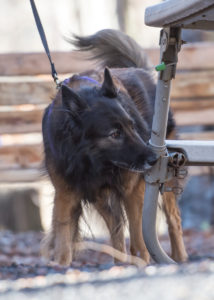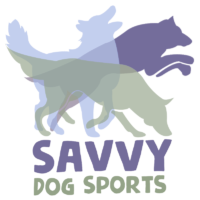Scent detection training is rapidly growing in popularity in the competitive dog sport community.
Known as Nosework or Scent Work, the sport involves searching for essential oils or handler scent, using training methods similar to what professional K9 detection trainers use when searching for bombs, drugs, contraband, or people.
The original sport of K9 Nosework initiated from explosives and narcotics scent detection trainers, realizing that every dog and dog lover would benefit and enjoy a sport based on real life detection training.
Scent work sports have certainly hit the mark, appealing to all kinds of dogs and handlers. From pet homes to performance homes – the sport has opened up new opportunities to train and bond with our dogs. The sport has done so much more … helping reactive and worried dogs build more confidence, improving cognitive function and providing an outlet for injured dogs on restrictive activity.
With a few modifications, we introduce odor using the same methods from professional K9 detection trainers. Dogs are strongly rewarded at odor with either food or toys. Once there is value for odor they learn to search using thought out exercises and drills.
In any new and growing sport, different ways emerge to teach skills and develop handling methods. This is normal and expected. Some methods and styles will “stick” while others will fade away or evolve.
With a strong influence from professional training techniques, we have to understand what makes sense for the sport. Professional detection training is based on “Ferrari” dogs. Dogs that are purposeful bred – fast and powerful. Most of us don’t have Ferraris. In the sport we have big dogs, little dogs, fast dogs, slow dogs, pet dogs, and performance dogs. They can be low arousal, high arousal, handler focused, worried, reactive, lack confidence and have environmental concerns. We have new dog trainers, accomplished dog sport trainers, and physically challenged handlers.
We can learn so much from K9 detection professionals! They have a wealth of knowledge on scent theory and scenting dogs. We also need to realize that the sport is different from professional K9 detection and not all methods will apply for all dogs or for all trial situations. There are also trends in the sport that require exposure/participation to keep your training plan current.
These scent sports are timed, verses real detection searches having more time to methodically cover an area. In the sport, multiple hides stay in the search area, can be placed very close creating converging odor, and require dogs to leave source to find another without going back. Our odors are very different from narcotics and bombs. Hides are mostly accessible verses deeply inaccessible with drugs and contraband. Dogs can seek out oils pretty quickly by following the scent cone and learning how to solve scent puzzles.
It’s important to realize that search strategies may differ for competition verses a real search situation. In competition, dogs usually find hides faster when searching independently. In early competition levels we know how many hides there are. Dogs can pick up odor from the start and find a hide in just a few seconds, finding all the hides pretty quickly to call Finish.
The professional detection method is heavily based on directing the search, using a pattern to methodically cover the search area. Scent walls and other apparatuses are used to train this methodical approach. It could take a team longer to find a hide if the dog is directed by the handler based on the handler’s strategy of covering the area. If the area is large like at Elite levels or national events, you’ll run out of time if you direct the whole search.
Being able to direct your dog in a search area is a very good skill to have. I use direction strategically to redirect my dog and to make sure all “air spaces” are covered. It is something I train for using easily acquired equipment to teach common concepts – chairs to direct down a line of objects or a cubby shoe holder for teaching dogs to hone in on the precise location of source. We have to know when to direct and when to hand the reins over to the dog. My concern is that many of our dogs will not respond well to an over directed search and it can affect the outcome negatively by running out of time, pulling dogs off odor or missing out on placements.
The key with any sport is to truly understand WHY a method or approach may help your team and IF it makes sense to you for your dog. Don’t fall for the flavor of the month. Been there, done that with agility. Expand your horizons and learn new methods, but understand the why of it and if it makes sense to you!
Just for fun, here’s a training session from today, prepping for an Elite trial end of month. Finding 5 hides in 2 minutes, mostly free searching with a bit of directing to cover the area! Good girl Savvy!

Glad to have found this blog (where did we get the name “blog” anyway???). I’ve taken classes with Julie and found her realistic and supportive of both me and my dog. I’ll check back here in the future!
Fantastic blog Julie!!!
I agree 100%!!! Especially as the driver of a Model T and a 1970’s VW Bug myself 😉
Hi Julie,
Loved the video! It sounded like your “judge” was calling “yes” when Savvy found odor and you just went in to feed…is that right or was it YOU saying “yes”?
Phyllis
That was me saying “yes”. I knew where the hides were as I set them for my class that morning. Ran 2 classes through this and then ran my dogs. I was a pretty good actor, huh? 🙂
Great article! I have tended to get confused by proponents of various scent detection training styles, but have just kind of chosen what works for my dog. I had to giggle in the video-my border collie has the same alert-finds the source then looks back at me.
It can be confusing in any sport with different or conflicting ideas/methods. It comes down to what makes sense to you. Understand what the new thing is for and why it works. Then you can pick what makes sense to you and discard the others.
I’ve worked hard to not have such a strong look back and instead stay at source. I’ve gotten her to go back at least :).
Excellent post, Julie!
Shared it with my Israeli Nosework group
Great blog, especially valuable to me since I am not competing and can decide everything about how I want my dog to find odor. Am I reading Savvy’s last find correctly? Savvy indicated correctly, but I think you were in a position where you couldn’t be sure her nose was in the right place and then you switched position for clarity and she indicated again. Right? I loved the effective way you encouraged her to find another.
Hi Sandy – thanks! I purposely waited like I might at a trial if I wasn’t sure (but she was very clear here). Since I knew where the hides were I was acting and proofing a bit so that she would insist/go back in case I do this at a trial. You’ll see at 1:54, her nose is always at source right before she looks at me. I prefer if she just stayed at source, but it’s years of accepting that behavior (the look back) and hard to change!
Thanks for the blog and the training video. What a great search. Savvy is awesome. I love the way she picked up the trapped odor on the one table, bracketed it, and then followed it back to the table behind for the source and the alert. I look forward to your next post.
Thanks Jim – my students ran this prior to Savvy and every dog went behind the table and sourced it from coming back around. The heater was on next to the window so odor was likely pooling over there. Also, there were some animal bones and skeletons on the window sill. Some who called their dog off that (which I appreciate so we don’t disturb any school items) were interrupted from searching and didn’t find it right away when coming around. I love learning how hide placements effect how dogs work!
Great blog. Large and complex area for searching – so many things for the scent to bounce off and around. Great job by Savvy. I assume you stood back to allow her to progress on her own search and not to disturb the “flow”of the odor.
yes, that is part of it with staying out of the way. The #1 handling error is crowding dogs. Crowding dogs can talk them into a non-hide. Crowding can block odor and disturb the flow and their ability to source the hide. I’m letting her pick up the scent and follow it to source. I also knew where the hides were so making sure I wasn’t aiding her in any way. I have the best seat in the house watching her work! 🙂
Thanks for writing this, Julie. Having been on both ‘sides’ of scent training, I agree completely that “Sport” folks and “Pro” folks have a great deal to offer each other. For me, I try to pick and choose methods and techniques that apply to my particular dog, at that particular time. We have benefited greatly from the variety! And I am most grateful for your classes and insight.
Thanks Pat :)! And we’ve learned about the difference in how the sport is judged for finding odor, then say search and rescue. And even better, how much I learn from students that come from different backgrounds and with scent detection experience!